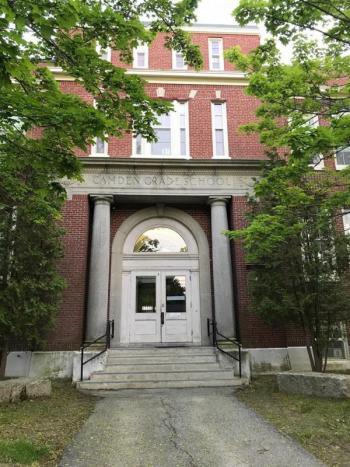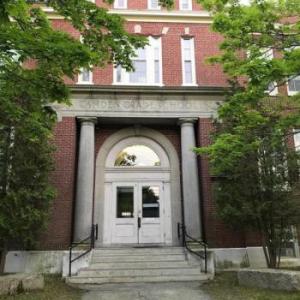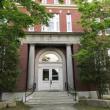Citizens appeal to Camden, Rockport select boards about school bond process
 The Mary E. Taylor building, constructed in 1925, has become a central point of debate in the Camden-Rockport community. The debate has prompted one Rockport citizen to appeal to the town select boards to review of the June 2017 new school bond process, and is asking that the Camden-Rockport School Board delay its decision on tearing down MET.
The Mary E. Taylor building, constructed in 1925, has become a central point of debate in the Camden-Rockport community. The debate has prompted one Rockport citizen to appeal to the town select boards to review of the June 2017 new school bond process, and is asking that the Camden-Rockport School Board delay its decision on tearing down MET.

 The Mary E. Taylor building, constructed in 1925, has become a central point of debate in the Camden-Rockport community. The debate has prompted one Rockport citizen to appeal to the town select boards to review of the June 2017 new school bond process, and is asking that the Camden-Rockport School Board delay its decision on tearing down MET.
The Mary E. Taylor building, constructed in 1925, has become a central point of debate in the Camden-Rockport community. The debate has prompted one Rockport citizen to appeal to the town select boards to review of the June 2017 new school bond process, and is asking that the Camden-Rockport School Board delay its decision on tearing down MET.

CAMDEN and ROCKPORT — On Monday, Nov. 13, the town managers of Camden and Rockport both received a package of documents relevant to last spring’s $26 million new school referendum, and a request that the leaders of both towns review the process by which voters were, or were not, aware that the demolition of the 1925-built Mary E. Taylor school building, on Knowlton Street in Camden, was included in that referendum.
The documents, which were addressed to Camden Town Manager Audra Caler-Bell and Rockport Town Manager Rick Bates, were also directed to all 10 select board members.
Along with a memo to the boards, the packaged also included an abridged collection of correspondence between the School Administrative District 28 board of directors, various citizens, town officials, as well as media, from Sept. 1, 2016 to Aug. 24, 2017.
It was all the result of a Freedom of Access Act (FOAA) request submitted Aug. 24 by Rockport resident Maggie Timmerman to SAD 28 Superintendent Maria Libby. Timmerman asked Libby to produce all emails pertaining to the Camden-Rockport Middle School project, specifically the demolition of the Mary E. Taylor building, “in relation to the new middle school construction project and referendum vote.”
Timmerman said in her FOAA request: “Multiple written and verbal assurances that the Mary E. Taylor building's demolition was not definitively tied to the approval of the new school referendum prior to the June 13, 2017 vote has led me to this decision. These assurances came from MSAD 28 Superintendent Maria Libby, school board members, and members of the project's public relations committee. The timeline of consult with legal counsel, holding of a public meeting on MET after the referendum vote, and admittance of an honest mistake over MET specific language within the proposal does not make me feel that all relevant information was shared with the public in a timely and transparent manner. I sincerely hope to be proven wrong.”
(See attached PDF for the full FOAA request)
(See sidebar below for the FOAA response, 390 pages represented in five documents)
In response to the Timmerman FOAA and her memo to select boards, Superintendent Libby has countered: “Once decisions were made, with widespread community input, it didn’t seem necessary to explicitly indicate that the MET wing would also be torn down. It is true that we didn’t say, ‘the old high school, the gym, the MET building, and the Andrews wing’ would be torn down because we didn’t think we needed to be that specific. However, we also never hid the fact that the plan was to demolish MET along with the rest of the building. The ballot question plainly and conspicuously states that the Project includes ‘Demolition of the middle school facility.”
The FOAA response
The following files contain all the emails concerning the Camden-Rockport Middle School bond referendum and MET’s future, as requested by Rockport citizen Maggie Timmerman.
She submitted the FOAA on Aug. 24.
The emails reflect school board and various committee excitement over the pending June referendum, and how to reach out to residents to get a positive vote on building a new school.
Their emails then reflect growing concerns about how to deal with citizen questions about the demolition of MET.
Some who served on the subcommittees wondered whether it would be wiser to disengage MET’s future from the bond vote.
There is name-calling in some of those emails, as well as much strategizing.
There are questions relayed to SAD 28 attorney William Stockmeyer, of the Portland-based Drummond Woodsum, for help in interpreting not only the language of the bond issue, but advice on how the district should move forward.
And, there is talk in those emails about transferring ownership of MET to the town.
On Nov. 17, SAD 28 School Board Chairman Matt Dailey said no proposals had been received to date from parties interested in repurposing MET.
But, in late August, local developer and real estate investor Stuart Smith had already begun talking, both in person and via email, with Superintendent Libby and others about renovating MET for administrative offices and the alternative high school Zenith program.
He produced, as evidenced in the FOAA response, a breakdown of costs for accomplishing such a project.
“Partner me with a few innovative thinkers and we can make this happen,” he said, in August.
But on Nov. 20, he said that those talks ended because the school board wanted to wait until the Nov. 30 deadline.
“They did not want to discuss it at all,” he said. “That makes it kind of hard to put together a proposal.”
Smith said: “I’m probably too busy right now,” he said. “It does not mean I don’t want to pursue it.”
He said the Nov. 30 deadline was “arbitrary” and MET does not need to be torn down for another year or more.
“There’s no rush,” he said. “It is not an integral part of the plan. I still consider it an very important asset to the community.”
The full FOAA response follows. Because the response comprised approximately 400 pages of emails, we have split them into batches.
Camden-Rockport Middle School FOAA, batch 1
Camden-Rockport Middle School FOAA, batch 2
Camden-Rockport Middle School FOAA, batch 3
Camden-Rockport Middle School FOAA, batch 4
On Nov. 16, Timmerman said she favored building a new school, and that the FOAA, “was in no way an attempt to derail the school project.”
However, she said: “I ultimately voted for the school bond but it wasn’t an easy decision for me. There were two items that concerned me: The total cost of the project and the fate of the MET building. In terms of cost, I felt and still feel that the $26 million price tag is too much. In Rockport, we have many folks who live on fixed incomes. We’re not just asking them to fund a middle school but a vocational school and potentially a new library, as well. I want our kids to have amazing schools but we have a fiscal responsibility to all of our taxpayers.”
After receiving the SAD 28 response to her FOAA on Sept. 17, and paying $210 to SAD 28 to fulfill that request (The first hour of sifting through old emails is free but the district then charges $15 per hour for each subsequent hour to collect the emails), she and Rockport resident Marci Casas began analyzing the material.
Casas, whose husband sits on the Rockport Select Board and the SAD 28 Building Committee, said she supported Timmerman in filing a FOAA. Comments made by SAD 28 School Board members at a June 15 meeting convened to discuss the future of MET was the catalyst for her involvement, she said.
“I supported the efforts to file the FOAA request after talking to several members of the community who felt mislead by the school board, superintendent, and building public relations committee,” Casas said, Nov. 16. “Superintendent Libby’s public statement six days before the new middle school vote and online chatter from the committee attempting to separate the MET demolition from the bond language was the main catalyst. Comments made by the school board chairman at the June 15 meeting discussing the fate of MET secured my doubt that the issue was mishandled.”
Timmerman said in her Nov. 14 note to the select boards that after reviewing the emails included in the FOAA response, “as well as other publically available information, has led to the compilation and submission of this document.”
She continued: “In addition to the aforementioned concerns, the fact that the MET building has recently been placed on Maine Preservation’s 2017 list of Maine’s Most Endangered Buildings further illustrates the importance of exercising extreme prudence in assessing the consequence of decisions surrounding the fate of the building.”
Both Casas and Timmerman are hoping the select boards will review the collected data sent to them.
“I’m hoping the Camden and Rockport select boards will review the emails and make their own determinations as representatives of the residents of their respective towns,” said Timmerman. “I want our elected officials to decide what, if any action, is appropriate. At minimum, I hope the looming deadline of Nov. 30 to find an investor for the MET building or seal its fate to be demolished can be extended while this matter is being reviewed.”
Casas said she wants the board to take up the issue: “jointly and pass it along for legal counsel for review. For me, this is about saving the MET building, a building that my grandmother attended, my father attended, and I attended. A building that is structurally sound and could serve a useful purpose well into the future. I also hope that the school board will move forward with efforts to Livestream their meetings to provide full transparency as both Camden and Rockport select boards have done.”
The MET issue
In mid-June 2017, Camden and Rockport voters approved building a new $26 million middle school on Knowlton Street in Camden, and the project is now proceeding through municipal site plan review.
On Nov. 9, three members of the Camden Planning Board agreed to send a recommendation to the Camden Select Board that it place on a town meeting warrant a land use ordinance amendment that, if approved by voters, would accommodate a new school whose height will exceed the existing 30-foot-height limitation by five feet.
Currently, Biddeford-based architects with Oak Point Associates are working with the Middle School Building Committee to finalize building designs.
The project entails demolishing the entire existing Knowlton Street Middle School campus. That campus consists of the Mary E. Taylor building, constructed in 1925, and then a series of wings over the last century that expanded the space to eventually include the former Camden-Rockport High School and middle school.
In 1999, the high school moved to its new building on Route 90 in Rockport, and Camden-Rockport grades 5-8 spread throughout the complex. Over the years, various repairs were made to the existing complex were made, as well as multiple studies of the physical plant. In 2014, the SAD 28 school board and administrators began talking about replacing it with a new structure.
In 2014-2015, voters first considered a $28 million school board proposal to tear down the existing campus, excepting MET, and replace it with a new building. That failed at the polls at special town meetings that were held in February 2015 in Camden and Rockport.
The school board and a building committee then revised plans and in 2016, presented the $26 million proposal to the public. In June, SAD 28 placed on the town ballots an article to build a new school.
The June warrant article before Camden and Rockport voters read:
Do you favor authorizing [SAD 28] to issue bonds or notes in the name of the district form school construction purposes in an amount not to exceed $25,200,000 to construct and equip a grade 5 through 8 middle school on the site of the existing Camden-Rockport Middle School, as described in greater detail below (‘the Project’)?
“The Project includes the following elements:
“a. New Construction
“b. Demolition of the existing middle school facility.
“c. To the extent, if any, needed for the development of the Project on the existing site, acquisition and conveyance of easements and other interests in real property.”
On June 13, 2017, voters in Camden approved the project 1,278 to 499. In Rockport, the approval was 669 to 396.
However, the issue had already gotten complicated when school board Chairman Matt Dailey said prior to the vote that the board would reconsider and revisit the question of demolishing MET at its June 15 school board meeting, the day after town meeting and two days after election day.
Some voters expressed confusion about what their vote had been based on. Some said they had voted for the entire campus to be razed. Others said they voted in favor of building a new school, but not at the expense of tearing down MET. They cited communications from the school board and Libby, who said SAD 28 had indicated a willingness to reconsider options for MET.
“I was confused about what the plan was leading up to the vote,” said Timmerman, Nov. 16. “It was still shown as standing on official site plans but not a lot was being said about it. Then the verbiage for the warrant came out and it seemed clear to me the intent was to demolish it. A beautiful building that, yes, needs extensive investment but is probably sturdier than most new buildings, is going to be demolished to make way for a practice field.”
She said in her memo to the select boards that despite significant outreach efforts, “school officials and volunteers failed to adequately explain to the community two major differences between the first failed bond referendum and the second that succeeded at the polls in June of this year:
“1. MET would not be part of the middle school building project, as it would be demolished along with the rest of the facility, and leasing or selling of MET to other entity was not an option.
“2. The fact that the 2017 bond proposal would leave unresolved the need for school district administrative offices and space for the Zenith program.”
Furthermore, she said that Libby had also stated publicly in news outlets, and prior to the vote, that MET was not necessarily destined for demolition.
“Although I still had concerns about the cost, it was this promise about the Mary E. Taylor building that pushed me over the line to vote in favor of the school bond,” said Timmerman.
“Rather than consulting legal counsel ahead of the vote to make sure that voters had correct information on the particulars of what they would be voting on, Superintendent Maria Libby issued a statement a week before the vote telling residents that demolition was a separate issue and that the referendum contained additional language that allowed them to do only what was necessary for the building of a new school,” said Timmerman, in her memo to the select boards.
She said she was shocked that within days following the June vote: “it was announced that, in fact, voters had approved to demolish MET. The public announcement that a vote for the school bond was not a vote to demolish MET was positioned as a mistake, that legal counsel wasn’t sought until after the vote and, in fact, to save MET would require a new voter referendum.”
On July 13, the school board tentatively agreed to hear ideas about saving the MET building after two hours of conversation at a special school board meeting held in the Camden-Rockport Middle School cafeteria. Approximately 30 citizens, including several Camden Select Board members, attended that meeting, where many told the board that the school board was obligated to allow time for proposals to percolate.
“When I watched the July school board meeting (being live-streamed by a member of the audience) and saw numerous residents who stood up to ask for an opportunity to investigate solutions for MET being basically rebuffed, I started questioning if there ever was a serious intent on behalf of those in charge of the school project to consider anything other than demolishing the building,” said Timmerman. It was after watching this meeting that I felt something maybe awry.”
During the summer, other citizens raised their voices in defense of demolishing MET, a video was produced to draw attention to its historic value and community relevance, and in early September, the nonprofit Maine Preservation placed MET on its 2017 Most Endangered List.
The school board set a Nov. 30 deadline for receiving proposals to keep MET standing.
As of Nov. 17, no one had submitted redevelopment ideas to the district about MET, said Matt Dailey, chairman of the school board. However, emails included in the FOAA response indicated that Camden resident Stuart Smith had begun a dialog with the superintendent about possibilities (see sidebar).
Superintendent and School Board chairman response
On Nov. 17, Libby responded to the FOAA submission to the select boards. She wrote:
“I think it is important to note that I don’t know Ms. Timmerman. To my knowledge, she did not attend any school board meetings, public hearings, or other public events where district personnel presented information about the project or vote. She did not attend the meetings specifically focused on the MET building in June or July of 2017. In fact, the first time I ever heard anything from her was her FOAA request this fall. The request was basically for all Superintendent and Board emails concerning MET between September, 2016 and September, 2017. It yielded nearly 900 pages of documents that took over 15 hours to compile. It also required over $2,000 in legal fees to support the request. The district worked hard and was thorough in providing all public records responsive to the request and we believe we did just that.
“Ms. Timmerman writes: Despite significant outreach efforts, school officials and volunteers failed to adequately explain to the community two major differences between the first failed bond referendum and the second that succeeded at the polls in June of this year:
“1. MET would not be part of the middle school building project, as it would be demolished along with the rest of the facility, and leasing or selling of MET to other entity was not an option.
“We presented three options to the community between the spring and fall of 2016: patch, renovate, and build new. It was abundantly clear that the first two options, patch and renovate, would maintain the MET building. It was also clear that building a new school meant tearing down the current one. When it became abundantly clear that the community supported a new school, the school board formally voted to demolish the MET wing of the school along with the other two sections of the school, namely the Andrews Wing and the Upper Wing. The ‘middle school’ would be demolished. CRMS is comprised of three parts, the MET wing, the Andrews Wing, and the Upper Wing.
“Once decisions were made, with widespread community input, it didn’t seem necessary to explicitly indicate that the MET wing would also be torn down. It is true that we didn’t say, ‘the old high school, the gym, the MET building, and the Andrews wing’ would be torn down because we didn’t think we needed to be that specific. However, we also never hid the fact that the plan was to demolish MET along with the rest of the building. The ballot question plainly and conspicuously states that the Project includes ‘Demolition of the middle school facility.’
“Using the language that we were going to demolish ‘the middle school facility’ was certainly not chosen to mislead the public. That phrase was used because typically when people indicate a school is going to be torn down, it means the whole school.
“2. The fact that the 2017 bond proposal would leave unresolved the need for school district administrative offices and space for the Zenith program.
“I very much appreciate the support for addressing the needs of the administrative offices and the Zenith program. There has been very little interest or support for addressing these concerns in the past, as indicated by the fact that the Central Office has been “temporarily” located in the Bus Barn for nearly two decades. The first bond failed and we heard from many that it was because of sticker shock. The most obvious way to reduce costs was to remove the Bus Barn/MET piece of the project and save $3.4 million in costs. We felt the priority was the new middle school, and if it meant sacrificing the needs of administration and the Zenith program, so be it. We shared that information every time we were asked, but it would have been highly unconventional to incorporate into the literature for the new project extensive details about what the project would not include. Furthermore, both the Central Office and Zenith are under the jurisdiction of the Five Town CSD district, not the MSAD #28 district. The MSAD #28 board clearly stated that they would place the resolution of those two issues with the Five Town CSD board. It should be noted that during the time I was working with the MSAD #28 board and community planning another attempt for a new middle school, I spent an intensive 8 months with an Ad Hoc committee of the Five Town CSD board working with realtors, architects, property owners, and our business manager evaluating over a dozen possible solutions to relocate Zenith and the Central Office.
“Concerns about demolition of the MET building began about a month before the vote, fueled primarily by one person who wanted to save it. That citizen has stated that she should have been paying more attention sooner. That doesn’t mean that we didn’t provide the information in a timely and accurate manner. It means that some people waited until the last minute to understand what was going on and take concrete steps to try to save a building.
“I have been amazed at the extent to which some citizens have gone to try to find fault with the process (and the people) as a means to achieve their desired outcome. As I stated in a very transparent way in my article titled Truth Be Told, we did word the bond language to demolish the middle school facility (again, not feeling it would be appropriate to name each part of the building) because that was the community input. When concerns arose, I believed that the bond allowed us to demolish the building, but did not require it, and conveyed this information to the public. Shortly after the vote, we got more nuanced information that anything other than demolition and new construction would require another vote. It didn’t prevent reconsideration of the future of MET, but it meant the path would require another referendum. When I learned this, I was very upfront about it and publicly shared it. We learn new information constantly – it doesn’t imply nefarious business. That chain of events transpired in an honest and well-intentioned manner. Those who imply that I “changed my story” are desperate to find something wrong with what we did because they want to save MET. A noble goal, but not one that should be pursued by trying to “expose” something that is not there.
“They are barking up the wrong tree. I am but an honest and incredibly hard working Superintendent with nothing to hide. The volume of material this FOAA request generated is evidence of that.
“Ms. Timmerman also seems concerned that we tried to separate the issue of MET from the vote. We did - to cater to those for whom MET was a tipping point in the vote. And we have successfully done precisely what we said we would do – reconsider the future of MET – on behalf of those who are actively criticizing us despite doing what they requested. For the past 6 months, we have dealt with the MET building separately. We have held two public meetings, we have outlined criteria for proposals, and we have given interested parties twice as long as they asked for to come up with a proposal to save MET. I have spent countless hours on the MET building since the June vote.
“Finally, if the Select Board is going to take any action on Ms. Timmerman’s request, I would trust they review the entire FOAA production, not merely the edited and annotated version provided by Ms. Timmerman.”
Chairman Dailey said on Nov. 17: All deliberations and decisions made by the SAD 28 School Board and its subcommittees are made in meetings open to the public. The years-long process that resulted in the voters of Camden and Rockport approving the construction of a new middle school was the result of not just numerous public school board meetings but also active engagement with municipal boards, community organizations, local media and town citizens. I am proud of the effort undertaken by school board members, building vision committee members and school administrators to honestly and completely inform the community about all aspects of the proposal to build a new middle school.
What is the role of Select Boards in school matters?
According to state law, municipal and public school governance are separate entities, and the voters are the ones that determine the respective budgets, policies and business.
But, there are joint concerns, and the fate of the MET building is a key example of how the entities are forced to work together. In September, the Camden Select Board met with the SAD 28 School Board and offered to set up a municipal committee to help process ideas and proposals that would keep MET standing.
That idea did not pan out, and the school board said it would be the entity to review any submissions for the future of MET. The board said it would entertain proposals until Nov. 30, and that such proposals would have to include dedicating half of the renovated MET space for SAD 28 administrative offices.
But Timmerman and Casas are suggesting the select boards ask legal counsel to review the FOAA material, and provide a recommendation to the select boards.
They also want the school boards, both SAD 28 and the Five Town CSD, to record and/or stream their meetings, to “strongly encourage full transparency.”
“It is the duty of our elected public officials to protect the interests of our residents, and ensure that all elected boards practice transparency in all conduct,” wrote Timmerman. “Additionally, it is the duty of these elected boards to protect the financial interests of all residents by ensuring proper allocation and use of taxpayer funds and resources.”
The Camden Select Board convenes Tuesday evening, Nov. 21, for a regularly scheduled meeting. There is no agenda item dedicated to the Timmerman request for the FOAA review but there is opportunity for any citizen or board member to address the matter during the public comment period.
As for Rockport, Town Manager Rick Bates said Nov. 15: “I have sent it [Timmerman’s package] along. Our board doesn’t meet again until December 7. Ken [McKinley, Rockport Select Board Chairman], has not decided yet, as he is digesting it all. I have sent it to Town Counsel as requested for his comments.”
Camden Select Board Chairman John French said Nov. 17 that municipalities do not have legal standing in school district affairs; however, he added that citizens have recourse by circulating a petition through both towns. A citizens’ initiative, he said, could be the route for the public to demand a revote on the future of MET.
Camden Select Board member Alison McKellar, who has been an avid supporter of not demolishing MET, said Nov. 17 that she was disappointed how the school district and committees conducted themselves in the lead-up to the June town meeting bond vote.
“It was a win-at-all costs campaign,” she said. “They acted more as a political action committee instead of a school district.”
She cited the correspondence contained in the FOAA response discussing the possibility of spending tay payer funds on magnets on school buses urging a yes vote on the bond (which ultimately was not done), an email urging seniors who turned 18 to vote in favor in the bond, and directing school employees to get quotes for signs.
“I don’t think you can use taxpayer money and resources to tell the taxpayers how to vote,” she said.
McKellar said she wanted to save MET.
“I believe strongly that there is a way to do that without it becoming a tax burden,” she said. “Once it’s gone, it’s gone.”
Related stories
Camden Planning Board chairman recuses himself from new school review
Camden Planning Board consider zoning changes to accommodate new middle school height
Heating Camden's new middle school from town's sewer plant: What's the cost and can it be done?
Owner's representative hired for new Camden-Rockport Middle School construction
Give community a chance to brainstorm about MET before tear-down, citizens tell school board
Camden Select Board hopes to meet with school board Thursday evening over MET future
Future of Camden's MET building to be discussed at two board meetings, municipal and school
Maria Libby on middle school project planning and Mary E. Taylor School
Camden-Rockport Middle School building project forum tonight
The future of Camden's Mary E. Taylor School. Tear it down? Lease it to another entity?
$28 million Camden-Rockport Middle School project proceeds to vote
Opinion: Camden Rockport Middle School project examined
Letter to the editor: School board responds to Camden Planning Board project concerns
Camden Planning concerns about middle school project
Camden-Rockport leaders skeptical of $28 million middle school project
Read about the March 20 forum: Camden-Rockport board endorses public straw vote: Tear down, rebuild middle school
What to do with Camden-Rockport Middle School: Tear down, renovate, rebuild?
Camden-Rockport Middle School concepts floated: ‘Everything in pencil’
Editorial Director Lynda Clancy can be reached at lyndaclancy@penbaypilot.com; 207-706-6657
Event Date
Address
United States

























